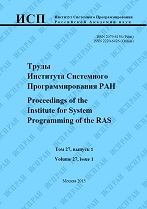|
Validation of open source code BEM++ for simulation of acoustic problems
P. S. Lukashina, S. V. Strijhakb, G. A. Scheglova
a Bauman Moscow State Technical University
b Institute for System Programming of the Russian Academy of Sciences
Abstract:
Testing of capabilities of open-source BEM++ code for simulation of acoustics problems at medium and high frequencies is presented. The BEM++ library is a universal tool, which allows to build discrete models for boundary integral operators (single-, double- and adjoint double-layer potential operators and hypersingular boundary operators) and solve boundary element method problems for Helmholtz, Laplace and Maxwell equations using Python libraries. Solution for the test problem of scattering plane wave on spherical obstacle with using BEM++ demonstrates good convergence with the results of analytical solutions. The relative errors satisfy to acceptable values 5% in solving engineering tasks, this fact allows to use this library as an alternative to commercial software. Capability of BEM++ library to calculate acoustic fields for frequencies from 5 Hz to 5 kHz enables move to solving more difficult engineering challenges of the aerospace industry. The main restriction for this is a time of computation, because only shared-memory technology of the code parallelization is implemented. However, open architecture of the library allows to remove this disadvantage. Meshes for BEM++ can have big size and be based on E geometric model with complex geometrical objects. Also, it should be noted, that for implementation to engineering practice it is desirable to integrate the library with existing interactive systems of pre- and post-processing, for example, with Salome.
Keywords:
Acoustics, boundary element method, scattering problem, BEM++, Helmholtz equation, rigid scattering, soft scattering, boundary integral equations.
Citation:
P. S. Lukashin, S. V. Strijhak, G. A. Scheglov, “Validation of open source code BEM++ for simulation of acoustic problems”, Proceedings of ISP RAS, 29:1 (2017), 39–52
Linking options:
https://www.mathnet.ru/eng/tisp99 https://www.mathnet.ru/eng/tisp/v29/i1/p39
|

| Statistics & downloads: |
| Abstract page: | 266 | | Full-text PDF : | 174 | | References: | 35 |
|




 Contact us:
Contact us: Terms of Use
Terms of Use
 Registration to the website
Registration to the website Logotypes
Logotypes








 Citation in format
Citation in format 